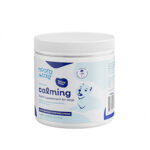I. Understanding User Pain Points

I. Understanding User Pain Points: Anxiety, Stress, and Behavioral Issues
For dog owners, witnessing their furry companions experiencing anxiety, stress, or behavioral problems can be deeply distressing. These issues can significantly impact a dog’s well-being, quality of life, and relationship with their human family.
-
Anxiety in Dogs: Anxiety in dogs manifests in various forms, including fear, nervousness, and restlessness. It can arise from a range of triggers, such as loud noises, unfamiliar people or animals, or separation from their owners.
-
Stressful Situations: Certain situations, such as vet visits, travel, or being in unfamiliar environments, can be highly stressful for dogs. These events can trigger anxiety and behavioral changes, making it challenging for owners to manage their pets’ responses.
-
Behavioral Issues: Some dogs may exhibit behavioral issues such as aggression, phobias, or destructive behavior. These issues can stem from underlying anxiety or stress, making it crucial to address the root cause to effectively resolve them.
II. Canine Tranquilizers: Classification and Mechanisms of Action
Canine tranquilizers, also known as sedatives or anti-anxiety medications, are drugs that are used to reduce anxiety and promote calmness in dogs. They can be classified into two broad categories based on their mechanism of action:
-
Benzodiazepines: These medications work by enhancing the effects of gamma-aminobutyric acid (GABA), a neurotransmitter that inhibits neural activity in the brain. Benzodiazepines, such as diazepam and alprazolam, produce a calming effect, reducing anxiety and promoting relaxation.
-
Non-Benzodiazepines: This class of tranquilizers includes a range of medications with different mechanisms of action. Some, such as gabapentin, target specific neurotransmitters involved in pain and anxiety pathways. Others, like acepromazine, act as alpha-adrenergic antagonists, reducing sympathetic nervous system activity and producing a sedative effect.
III. Uses of Canine Tranquilizers
Canine tranquilizers are primarily used in the following situations:
-
Anxiety Management: Tranquilizers can significantly reduce anxiety in dogs during stressful situations or events that trigger fear or nervousness.
-
Sedation for Procedures: Tranquilizers are commonly used to sedate dogs for veterinary procedures such as examinations, surgeries, or dental work.
-
Behavioral Modification: Tranquilizers can be used as part of a comprehensive treatment plan to address behavioral issues in dogs. By reducing anxiety and stress, they can facilitate the training and modification of unwanted behaviors.
IV. Administration and Monitoring
Canine tranquilizers are typically administered orally in tablet or liquid form. The dosage and frequency of administration depend on the specific medication, the dog’s size, and the severity of their anxiety or stress. It is crucial to follow the veterinarian’s instructions carefully and monitor the dog’s response to ensure optimal efficacy and safety.
V. Side Effects and Precautions
Like any medication, canine tranquilizers can have potential side effects, including sedation, drowsiness, nausea, and changes in appetite. It is important to note that some medications may interact with other medications or underlying health conditions. Therefore, owners should always consult with their veterinarian before administering any tranquilizers to their dogs.
VI. Conclusion
Canine tranquilizers are valuable medications that can effectively reduce anxiety and promote calmness in dogs. By addressing the underlying causes of anxiety, stress, or behavioral issues, tranquilizers can significantly improve the well-being of dogs and strengthen the bond they share with their owners. However, it is crucial to administer and monitor tranquilizers carefully, following the veterinarian’s instructions and being aware of potential side effects and precautions.
II. Types and Mechanisms of Action

Canine tranquilizers are medications used to reduce anxiety and agitation in dogs. They are commonly employed in various situations, such as veterinary procedures, travel, and noise phobias. Understanding the different types and mechanisms of action of canine tranquilizers is crucial for their safe and effective use.
Types of Canine Tranquilizers
1. Benzodiazepines
Benzodiazepines are the most commonly used class of tranquilizers for dogs. They work by enhancing the inhibitory effects of gamma-aminobutyric acid (GABA), a neurotransmitter that promotes relaxation. Common benzodiazepines used in veterinary medicine include:
- Diazepam (Valium)
- Alprazolam (Xanax)
- Lorazepam (Ativan)
2. Neuroleptics
Neuroleptics are a class of drugs that block dopamine receptors in the brain. This results in a reduction in locomotor activity and arousal. Common neuroleptics used in dogs include:
- Acepromazine (Acepromazine)
- Chlorpromazine (Thorazine)
3. Antipsychotics
Antipsychotics are a class of drugs that are primarily used to treat psychosis in humans. However, some antipsychotics have been found to have tranquilizing effects in dogs. They work by blocking dopamine and serotonin receptors in the brain. Common antipsychotics used in dogs include:
- Risperidone (Risperdal)
- Olanzapine (Zyprexa)
Mechanisms of Action
Benzodiazepines:
Benzodiazepines bind to specific receptors in the brain and enhance the effects of GABA, an inhibitory neurotransmitter. This leads to a decrease in neuronal excitability, resulting in sedation, muscle relaxation, and anti-anxiety effects.
Neuroleptics:
Neuroleptics block dopamine receptors, particularly D2 receptors, in the brain. This reduces dopamine’s stimulatory effects, resulting in sedation, decreased motor activity, and a calming effect.
Antipsychotics:
Antipsychotics block dopamine and serotonin receptors in the brain. This inhibits the stimulatory effects of these neurotransmitters, leading to sedation and anti-anxiety effects. Some antipsychotics also have anti-emetic properties, which can be beneficial for dogs experiencing motion sickness or nausea.
Factors to Consider When Choosing a Tranquilizer
The choice of canine tranquilizer depends on several factors, including:
- The dog’s age, weight, and health status
- The severity of anxiety
- The duration of the desired effect
- The potential for side effects
It is important to consult with a veterinarian before administering any tranquilizer to a dog. The veterinarian can determine the appropriate type and dosage based on the individual dog’s needs and minimize the risk of adverse reactions.
III. In-Depth Examination of Effects

Sedative Effects
Canine tranquilizers primarily exert their sedative effects through the activation of the gamma-aminobutyric acid (GABA) receptor. GABA, a neurotransmitter, plays a crucial role in regulating neural excitability and reducing anxiety. Tranquilizers potentiate the inhibitory effects of GABA, resulting in decreased neuronal firing and a calming effect on the central nervous system. This sedative action manifests in reduced restlessness, agitation, and hyperactivity in dogs.
Tranquilizers can be categorized based on their sedative potency:
- Benzodiazepines: High potency, rapid onset, and relatively short duration of action. Examples include diazepam and alprazolam.
- Non-benzodiazepine anxiolytics: Lower potency than benzodiazepines but offer a longer duration of action. Examples include buspirone and gabapentin.
- Antihistamines: Possess sedative properties as a side effect. Examples include diphenhydramine and chlorpheniramine.
Anxiolytic Effects
Beyond their sedative effects, canine tranquilizers also possess anxiolytic properties. Anxiety in dogs can manifest in various forms, including fearfulness, avoidance behaviors, and compulsive actions. Tranquilizers alleviate anxiety by reducing the activity of the amygdala, a brain region involved in processing emotional responses.
The anxiolytic effects of tranquilizers can be beneficial in managing a range of anxiety-related conditions in dogs:
- Generalized anxiety disorder: Chronic and excessive worry without an identifiable trigger.
- Separation anxiety: Fear or distress experienced when separated from a primary caregiver.
- Social anxiety: Fear or discomfort in social interactions with other animals or humans.
Antipsychotic Effects
Some canine tranquilizers, particularly those from the benzodiazepine class, have demonstrated antipsychotic properties. Psychosis in dogs refers to a state of altered reality and behavior, often characterized by hallucinations, delusions, and disorganized thinking.
The antipsychotic effects of tranquilizers are mediated through their ability to block dopamine receptors in the brain. Dopamine, a neurotransmitter involved in reward and motivation, is implicated in the development of psychotic symptoms. By reducing dopaminergic activity, tranquilizers can ameliorate hallucinations and delusions, and improve cognitive function.
Tranquilizers are used in the treatment of canine psychosis, such as:
- Canine cognitive dysfunction syndrome (CCDS): Age-related cognitive decline characterized by disorientation, confusion, and behavioral changes.
- Schizophrenia-like psychosis: A rare disorder in dogs that resembles schizophrenia in humans, involving hallucinations, delusions, and disorganized behavior.
Conclusion
Canine tranquilizers exert a range of effects on sed
IV. Providing Fresh Perspectives

Pharmacological interventions, such as canine tranquilizers, have become a common means of managing anxious or aggressive behaviors in dogs. However, the use of these medications can raise concerns about potential side effects and long-term health implications. Non-pharmacological alternatives offer a promising avenue for addressing anxiety and aggression in dogs without resorting to medication.
Behavior modification is a fundamental aspect of non-pharmacological management. This involves modifying the dog’s environment, training, and socialization patterns to reduce triggers that elicit anxious or aggressive responses. Techniques such as positive reinforcement, desensitization, and counter-conditioning aim to reshape the dog’s behaviors and build confidence in specific situations.
Herbal remedies, such as chamomile, valerian root, and lavender, have been traditionally used for their calming effects in humans. While evidence for their efficacy in dogs is limited, some studies suggest that these herbs may help reduce anxiety and promote relaxation. However, it is crucial to note that herbal remedies should be used with caution and in consultation with a veterinarian, as some herbs can interact with medications or have potential health risks.
Proper diagnosis and use of both pharmacological and non-pharmacological interventions is paramount for successful management of anxiety and aggression in dogs. Veterinary behaviorists and certified dog trainers can provide comprehensive evaluations to determine the underlying causes of these behaviors and develop individualized treatment plans that incorporate appropriate non-pharmacological techniques.
Behavior Modification Techniques
- Positive reinforcement: Rewarding desired behaviors, such as calmness or appropriate social interactions, to encourage the dog to repeat them.
- Desensitization: Gradual exposure to anxiety-provoking triggers in controlled settings, allowing the dog to build tolerance and reduce fear responses.
- Counter-conditioning: Pairing anxiety-provoking triggers with positive experiences to create a new association and reduce negative reactions.
Herbal Remedies
- Chamomile: Contains compounds with mild sedative and anti-anxiety properties.
- Valerian root: Known for its calming and sleep-inducing effects.
- Lavender: Elicits a calming response through its scent.
Importance of Veterinary Consultation
- Accurate diagnosis: Behavior problems can have various underlying medical conditions, which need to be ruled out before implementing any interventions.
- Appropriate medication: If non-pharmacological measures prove insufficient, a veterinarian can prescribe appropriate tranquilizers while minimizing the risks of adverse effects.
- Monitoring: Regular veterinary follow-ups are essential to monitor the dog’s progress, adjust treatment plans as needed, and ensure the overall health and well-being of the animal.
By embracing non-pharmacological approaches and consulting with veterinary professionals, dog owners can effectively address canine anxiety and aggression without compromising the health and well-being of their beloved companions. The combination of behavior modification techniques, herbal remedies, and appropriate veterinary care provides a holistic and evidence-based approach to promoting tranquility and harmony in dogs.
VI. Buying Guide and FAQs
Factors to Consider When Choosing a Tranquilizer:
- Reason for Use: Determine the specific reason for tranquilizing your dog, such as anxiety, motion sickness, or travel.
- Type of Tranquilizer: There are three main types of tranquilizers: sedatives, anti-anxiety medications, and specific-purpose medications (e.g., for motion sickness).
- Potency: Consider the severity of your dog’s anxiety and the desired duration of the tranquilization.
- Dosage: Determine the appropriate dosage based on your dog’s weight, age, and health conditions.
- Side Effects: Tranquilizers can have various side effects, such as drowsiness, gastrointestinal upset, and respiratory depression.
- Veterinary Consultation: Always consult with a veterinarian before administering any tranquilizers to your dog.
Common FAQs about Canine Tranquilizers:
Q: Are tranquilizers safe for dogs?
A: Yes, when used appropriately and under veterinary supervision. However, certain health conditions and medications can affect the safety of tranquilizers.
Q: What are the potential side effects of tranquilizers in dogs?
A: Side effects may include drowsiness, vomiting, diarrhea, incoordination, and in rare cases, respiratory depression.
Q: How long do tranquilizers last in dogs?
A: The duration of action varies depending on the type and dosage of the tranquilizer. Typically, it ranges from a few hours to several days.
Q: Can I give my dog tranquilizers without veterinary approval?
A: No, it is crucial to obtain a veterinarian’s prescription and follow their instructions carefully to ensure the safety and efficacy of the medication.
Q: What is the difference between sedatives and anti-anxiety medications?
A: Sedatives primarily induce sleepiness and relaxation, while anti-anxiety medications focus on reducing anxiety and fear without causing drowsiness.
Q: Are there any natural or herbal alternatives to canine tranquilizers?
A: While certain supplements like valerian root and chamomile may have calming effects, they are not substitutes for prescribed tranquilizers. Consult with your veterinarian before using any herbal remedies.
Q: Can I use human tranquilizers on dogs?
A: No, human tranquilizers are not safe for dogs and can cause severe adverse effects. Always use canine-specific tranquilizers prescribed by a veterinarian.
Q: What should I do if I suspect my dog has an adverse reaction to a tranquilizer?
A: Contact your veterinarian immediately and provide detailed information about the tranquilizer, dosage, and any observed symptoms.
Conclusion:
Choosing the right tranquilizer for your dog requires careful consideration of individual factors and consultation with a veterinarian. By understanding the different types of tranquilizers, potential side effects, and safety concerns, you can ensure the well-being of your furry companion during stressful situations.


















